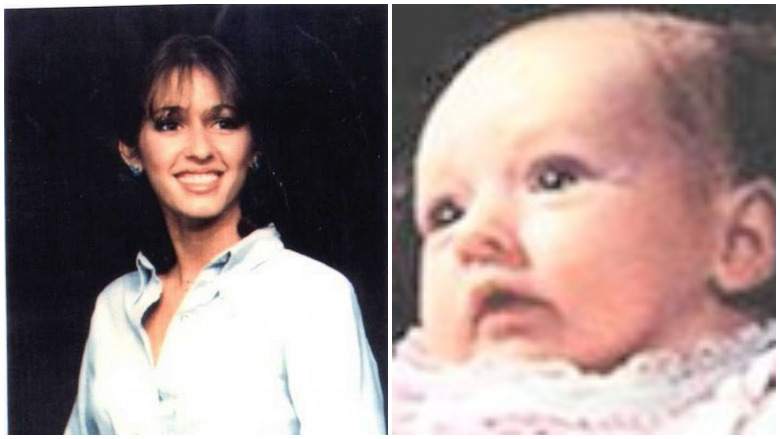
Charley Project Heather Tiffany Robinson (r) and her mother Lisa Stasi.
The murder of Heather Tiffany Robinson’s mother Lisa Stasi was orchestrated, authorities say, by a Kansas serial killer who wanted a baby for his brother and sister-in-law.
John Edward Robinson Sr. was accused of slaying multiple other women he put in a storage locker and barrels on his property, according to a Supreme Court decision from Kansas; altogether, he’s suspected of at least eight homicides (five in Missouri and three in Kansas). The bizarre case was featured on ABC’s 20/20 on October 4, 2019. The television program features an interview with Heather Tiffany Robinson, who knew Robinson as “Uncle John” before discovering her true identity. She was being raised by the family of the serial killer who murdered her missing mother.
Today, John Edward Robinson is 75 years old and incarcerated in the Kansas prison system. Heather Robinson is searching for her mother’s remains, which have never been found, although Robinson was initially convicted of Lisa Stasi’s murder.
The state Supreme Court in Kansas later vacated the convictions in the Stasi case and victim Izabela Lewicka’s death. However, Robinson remains on death row because the Kansas court upheld one capital murder conviction for the death of Suzette Trouten. The court wrote, “In sum, we affirm Robinson’s capital murder conviction charged in Count II (Suzette Trouten’s death). We reverse his capital murder conviction charged in Count III (Izabela Lewicka’s death) and his first-degree murder conviction charged in Count V (Lisa Stasi’s disappearance) as unconstitutionally multiplicitous with the capital murder conviction in Count II.” You can read that extremely lengthy decision here. The aggravated Interference With Parental Custody conviction in the Stasi case was upheld.
“Justice and closure for me is finding her remains and giving her a proper burial,” Heather Robinson said to 20/20. “Closure is knowing exactly what happened, and peace is finally being able to definitively say Lisa was a person, this is what they did to her, this is where she is and then to be able to finally move on with my life.”
Here’s what you need to know:
1. Robinson Told Stasi He Would Help Her Get Job Training, Police Say

Aerial view of suspected serial killer John Edward Robinson Sr.’s home June 6, 2000 in Linn County, Kansas.
How did the serial killer cross paths with Stasi and her baby? Authorities say they met in 1984. She was newly separated, only 19, and he told her “he could get her into a job-training program in Texas,” according to The Chicago Tribune.
According to the court records, Robinson’s name “surfaced early in the investigation. On February 1, 1985, Overland Park detectives interviewed Robinson, who told them he was starting a charitable organization to provide young mothers job training, food, and housing. Robinson admitted he had placed Stasi at the Roadway Inn as part of that program. However, he said Stasi had recently come to his office to give him the motel key. Robinson said Stasi thanked him for the assistance and said she had made other arrangements. Robinson claimed that Stasi and Tiffany left with a young Caucasian male in an older model green car.”
One week later, the records say, “Robinson provided a similar story to his Missouri Parole and Probation Officer, Steve Haymes. Robinson told Haymes he had placed Stasi at the Roadway Inn, but on January 10, she and Tiffany came to his business with a man named Bill and said they planned to start a new life together in Colorado. To corroborate this story, Robinson paid Cora Holmes $800 in exchange for her false statement to police. At Robinson’s direction, Holmes told Overland Park detectives that she had recently babysat Tiffany and learned Stasi had left for Arkansas with a man named Bill Summers.”
Lisa Stasi’s decision to stay at the Rodeway Inn in Overland Park, Kansas in January 1985 sealed her fate, and she took her 4-month-old baby daughter Tiffany with her. Lisa was never seen again, and her body was never found. This was Robinson’s M.O., according to authorities. He would prey on women at a vulnerable moment in their lives, either financially or because of broken or lost relationships.
According to CNN, authorities think Robinson killed her one day before handing over the baby to relatives. At that time, Heather Robinson was known as Tiffany Stasi.
Police say Robinson murdered Stasi and gave her baby daughter to his brother and sister-in-law, Don and Helen Robinson, who wanted children but didn’t have them.
“I want to find out where she is. I want to know who she was,” Heather Robinson said of her mother to 20/20. “She was a scared, abused, 19-year-old girl with a newborn, desperate to keep her child [and] be a mother. That was the whole reason John got her… I know I will. I’ll find her.”
In November 1984, Robinson had contacted Karen Gaddis, a social worker at Truman Medical Center, the court records say, and “told her that he and several Johnson County businessmen had developed a program to provide housing, transportation, daycare, and job training for young mothers and their babies.”
“Robinson said he needed referrals of Caucasian women because the program already had African–American participants and needed racial balance. Robinson was looking for a white woman in her teens or early 20s, who had a newborn child, was struggling or disadvantaged, and had no family support or ties. In January 1985, Robinson told Gaddis another organization, Hope House, had referred a young lady to his program, and he had placed her at a motel in Kansas. Lisa Stasi’s aunt, Karen Moore, testified that she had contacted Hope House and took Stasi to the organization just before January 1, 1985.”
2. Don & Helen Robinson Testified at Robinson’s Trial That They Never Suspected the Secret Behind the Adoption
Tiffany’s adoptive parents, Don and Frieda Helene Robinson (often known simply as Helen), testified during Robinson’s trial. According to CNN, they described flying to Kansas City from their home in Chicago in January 1985 to pick up the baby.
In court, the Robinsons claimed that John Edward Robinson, who was Don’s elder brother, told them that the mother wanted to give the baby up for adoption. He spun an elaborate tale, according to their testimony, telling them that the mother killed herself after abandoning the child in a shelter. It wasn’t true, of course. Don and Helen weren’t charged because it was believed they were oblivious to John Edward Robinson’s true scheme.
“Robinson was looking for a private adoption opportunity for his younger brother, Donald Robinson, and Donald’s wife, Helen, who lived in the Chicago area,” the Supreme Court case said. “At a family reunion in 1983, Donald and Helen told Robinson they were pursuing a private adoption. Robinson said he knew an adoption attorney, Doug Wood, and would handle the process for his younger brother. In fall 1984, Robinson told Donald and Helen a baby would be available in October. At Robinson’s direction, Donald sent him a $2,500 cashier’s check payable to Robinson’s business, Equi II, allegedly to cover adoption-related fees. Robinson later said the birth mother had decided not to place the child for adoption.”
“We named her Heather Tiffany Robinson,” Don Robinson testified, according to CNN, because Tiffany was the name that John Edward Robinson claimed the child’s mother had given her. “…we wanted to keep that in some way.”
Nancy Robinson, the wife of John Edward Robinson Sr., testified that in early January 1985, “the day of the terrible snowstorm, Robinson brought a baby to their home in Stanley. Robinson said that the baby’s name was Tiffany and that he received her through a private adoption for his brother. Robinson called Donald and Helen and told them a baby was available immediately. He said the birth mother had decided against adoption after delivery, but the family did not support her decision, so she left the baby at a shelter and committed suicide.”
Donald and Helen flew to Kansas City on January 10. Robinson “picked them up at the airport in the late afternoon and drove them to the offices of Equi II in Overland Park, where they signed legal paperwork, including a Petition for Adoption. After signing the documents, Donald gave Robinson a $3,000 cashier’s check payable to Doug Wood, allegedly for further adoption expenses. Donald and Helen named the baby Heather Tiffany Robinson. They returned to Chicago, along with the baby, the following day,” the records say.
In July 1985, the records continue, Donald and Helen “received a package from Robinson containing final adoption paperwork, including a Petition for Adoption, Decree of Adoption, birth certificate, and other documents. The Petition appeared to be signed by attorney Douglas Wood, who had handled over 100 adoptions in his career. Wood testified that he did not prepare the document, that it deviated from his standard form, and that his signature had been forged. Wood confirmed that he had never represented Robinson or any member of his family in any adoption proceeding nor received payment from Robinson for such legal work.”
After Robinson’s arrest in 2000, Donald and Helen “began to question the identity of Heather’s birth mother. Law enforcement compared Heather’s footprints to the known prints of Tiffany and found the prints matched, i.e., Heather Tiffany Robinson was Tiffany, Stasi’s biological daughter,” the records say.
3. Lisa Stasi Met Robinson in a Battered Women’s Shelter & Made a Strange Phone Call Before She Disappeared

Lisa Stasi
John Edward Robinson was born in Cicero, Illinois. He was the third of the five children born to Alberta and Henry Robinson. According to a Radford.edu timeline on his life, he was named an Eagle Scout and attended a seminary. He became an X-ray technician, married, and had several children of his own.
Robinson’s father was a binge drinking machinist and his mother was a homemaker, according to CourtTV. As an Eagle Scout, CourtTV reported, he once “sang for the Queen of England and received a kiss from actress Judy Garland backstage.”
He was convicted of theft for embezzling money from an employer and then started selling insurance. He started a medical consulting business and got into more trouble for financial crimes. Eventually he started a company called Hydro-Gro.
He met Lisa Stasi and her baby “at a battered women’s shelter in Kansas City,” the timeline says. He claimed his name was John Osborne and picked up Lisa and Tiffany at Lisa’s sister’s home.
Lisa Stasi’s mother in law, Betty Stasi, was the last person to hear from her. Lisa stated that “they” claimed Lisa was not a fit mother and that “Betty wanted custody of Tiffany,” which Betty denied. Lisa said “here they come,” and the phone disconnected. Lisa also said that “John Osborne” had asked her to sign several blank sheets of paper, according to CourtTV. Lisa was hysterical in the phone call, according to ABC.
Later, relatives received letters, supposedly from Lisa. Police believe Robinson wrote them to pretend the murdered mother had left voluntarily. According to ABC, one letter said, “I want to thank you for all your help. I’ve decided to get away from this area and try to make a good life for me and Tiffany.”
Family members last saw Stasi and Tiffany in early January 1985, according to the court case records. The sister of Lisa’s estranged husband Carl, Kathy Klingensmith, “babysat Tiffany often. On January 8, Stasi dropped Tiffany off at Klingensmith’s home and told her she had met a man named John Osborne, who was going to help her get a job and finish her GED. Stasi said she might even get to travel as part of the job training program,” the records say.
“Stasi returned to Klingensmith’s home to pick up Tiffany on January 9. When she arrived, Stasi said John Osborne had paid for her to stay in a room at the Roadway Inn in Overland Park. At approximately 2 p.m., Stasi called the front desk at the Roadway Inn and gave the hotel receptionist Klingensmith’s phone number in case Osborne called. Osborne called Klingensmith’s number soon thereafter and got directions to her home. The weather was treacherous because of a strong snowstorm, but Osborne arrived at Klingensmith’s home at approximately 3 p.m. Stasi and Tiffany went with Osborne, leaving Stasi’s car parked outside Klingensmith’s home. Less than 1 hour later, Stasi called Klingensmith to tell her she had arrived safely at the motel. Klingensmith never saw or heard from Stasi or Tiffany again. Stasi never returned for her car. Klingensmith identified Robinson at trial as the man she knew as John Osborne.”
Around 4:30 p.m., the records continue, Stasi “called her mother-in-law, Betty Stasi, in a panic, crying and hysterical. Stasi said ‘they’ were claiming that Betty Stasi planned to take Tiffany away because Stasi was an unfit mother. Stasi’s mother-in-law told her not to believe what ‘they’ were saying because it was not true. Stasi said ‘they’ wanted her to sign four blank sheets of paper. Betty Stasi told her not to sign anything. Stasi said ‘here they come,’ and she hung up.”
4. Robinson Was Known as the ‘Slavemaster’ & Lured Some of His Victims Through Internet Chatrooms

Lisa Stasi
Some people have dubbed Robinson the first Internet serial killer because he used electronic means – Internet chatrooms – to lure some of his victims to their deaths. He used the name Slavemaster online. He was discovered after a 2000 sexual assault arrest, according to ABC.
The court records gave these details on the other women Robinson was accused of slaying. Suzanne Trouten was from Michigan and active in the BDS&M community, frequenting chat rooms and traveling out of state for “BDS&M trysts.” She placed ads on such websites seeking a position as a “slave.” She later told her mother that Robinson “had offered her a job caring for his elderly father, ‘Papa John.’” She agreed to take the job and traveled to Kansas. Robinson admitted engaging in a sexual relationship with Robinson that included a “slave” contract and videotape. At this point, she disappeared. Her mother later received letters from her that authorities think were actually written by Robinson.
Izabela Lewicka was born in Poland and raised in Indiana. She studied at Purdue University and developed an interest in paganism, goth and BDS&M lifestyles, the court records say. She told a friend she was moving to Kansas City to be with an older married man who had offered her a job doing secretarial work and illustrating BDS&M manuscripts. He was going to train her to become a dominant and wanted her to call him master. In Kansas, she worked for a Robinson magazine handling advertising graphics and would indicate she was Robinson’s wife. Authorities also found a “slave contract” in this case. Sometime in late summer or fall 1999, Lewicka disappeared.
Beverly Bonner was from Missouri, where she lived with her doctor husband and two sons. She was a prison librarian at the prison where Robinson was an inmate. Her husband was a prison physician who treated Robinson. She filed for divorce in 1993. She told her husband she was helping Robinson “find property for a hydroponics project” and planned to take a job with a Chicago company.
She then disappeared, and Robinson stole her alimony payments, court records say. Once again, the victim’s family received fraudulent letters really from Robinson.
Sheila Faith had a baby girl named Debbie Lynn in 1978. Debbie had cerebral palsy. When Sheila’s husband died, she moved to Colorado with the girl and lived on Social Security. She had interest in BDS&M and responded to personal ads, eventually meeting a man named “John” who promised to take her on a cruise and put Debbie in private school. She said she and Debbie were going to meet John but neither was seen again.
Vickie Neufeld was from Texas and had lost her job as a geriatric therapist. She put personal ads on BDS&M websites and started emailing Robinson. He sent her a slave contract, the court records say.
He said he was a wealthy businessman and promised to support her, arranging for her to stay in a hotel. She survived and filed a police report when he wouldn’t return her property, including sex toys. That started a police investigation, as did a missing person’s report about Trouten.
Authorities found Trouten in a barrel with a soft, nylon rope tied around the head. A head injury was lethal. Lewicka was found in the second barrel, in a nightshirt, partially covered. There were two blunt force injuries to the skull.
The storage unit had three barrels. In one was Bonner, dressed for cold weather, her body curled up inside. She had trauma to the head, consistent with a hammer. Sheila was found there also, again with injuries similar to a hammer. She was wrapped in plastic. Debbie was fully clothed and wearing an adult disposable diaper. She had three blows to the head.
Robinson is also suspected of killing Paula Godfrey, who was working at one of his businesses. She has been missing since 1984. Another possible Robinson victim is Catherine Clampitt, another missing employee.
According to CourtTV, Robinson lured some of his victims with “promises of money and jobs and requests for sadomasochistic sex.” In 2000, according to CourtTV, it unraveled when authorities discovered the remains of two women stuffed inside “two 55-gallon barrels sitting out in the open on rural property near La Cygne, Kan.” A storage locker with the remains of three other women was searched next. However, none of those women was Lisa Stasi.
Robinson’s family, including his wife and two daughters, stayed at his side throughout the trial, according to CourtTV, which quoted a family statement as saying, “The John Robinson we know has always been a loving and caring husband and father, the type of parent who never missed a sporting event, a school function or an opportunity to be there for his family. We do not know the person whom we have read and heard about on TV.”
Heather Robinson told ABC that “Uncle John” always gave her an odd feeling. “[John Robinson] always gave me this really weird, off-putting feeling in the pit of my stomach,” she said to 20/20. “It’s like walking down a dark alley in the middle of the night while you know someone is behind you, approaching you closer and closer.”
5. Lisa Stasi’s Husband Entered the Military After the Marriage Became Troubled

Lisa Stasi
What of Tiffany’s real father? His name was Carl Stasi, and Lisa married him in her hometown of Huntsville, Alabama in August 1984, one month before Tiffany Lynn was born, according to the Charley Project. They moved to Kansas City, Kansas because he didn’t have insurance.
Carl moved to Illinois after re-enlisting in the military, according to Charley Project, which described the Stasi marriage as “troubled.” It’s at that point that Lisa and Tiffany ended up in the battered women’s shelter.
According to the Supreme Court case, “Lisa Stasi, formerly Lisa Elledge, was 18 years old when she began dating Carl Stasi sometime after June 1983. Lisa married Carl in August 1984. She was pregnant at the time. On September 3, 1984, Lisa Stasi gave birth to her first child, Tiffany Lynn, at Truman Medical Center in Kansas City, Missouri. After Tiffany’s birth, Stasi’s marriage crumbled and Carl reenlisted in the Navy. He reported for duty at Great Lakes Naval Base, outside Chicago, Illinois, in early January 1985.”
Lisa told her family members that she was joining the Kansas City Outreach Program for young mothers. According to ABC, prosecutors say that was a scam and Robinson would go to hospitals to offer the program for “downtrodden women.” He was traced, in part, through a credit card used to book the hotel room where Lisa was staying.
According to ABC, Heather Robinson has chosen not to have a relationship with her biological dad, although she did get to know Stasi’s mom. Don Robinson and his wife legally adopted her, and she kept their name. She told ABC of Don Robinson: “…inside, in my heart, I have a dad, I don’t need another one.”
